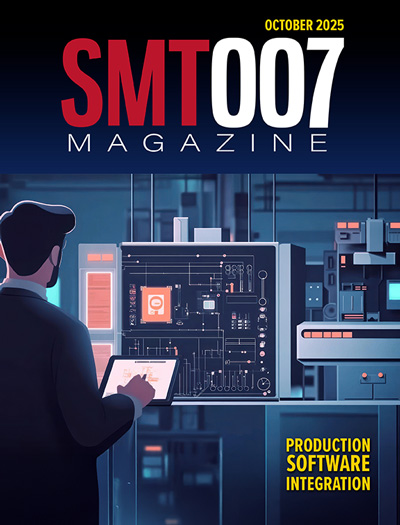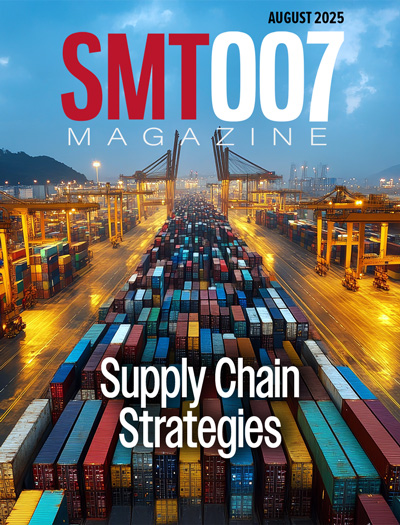-

- News
- Books
Featured Books
- smt007 Magazine
Latest Issues
Current Issue
Production Software Integration
EMS companies need advanced software systems to thrive and compete. But these systems require significant effort to integrate and deploy. What is the reality, and how can we make it easier for everyone?

Spotlight on India
We invite you on a virtual tour of India’s thriving ecosystem, guided by the Global Electronics Association’s India office staff, who share their insights into the region’s growth and opportunities.

Supply Chain Strategies
A successful brand is built on strong customer relationships—anchored by a well-orchestrated supply chain at its core. This month, we look at how managing your supply chain directly influences customer perception.
- Articles
- Columns
- Links
- Media kit
||| MENU - smt007 Magazine
Cost-optimize Your PCB Design and Specifications
August 20, 2024 | Erik Pedersen and Richard Koensgen, ICAPE GroupEstimated reading time: 1 minute
Knowledge is the key to identifying the small details that makes the big cost difference for your printed circuit board. There are many types of printed circuit boards and multiple choices between the development of schematic and BOM to PCB technology selection, electronic PCB design, mechanical and physical properties, and PCB specification.
Component Technology and BGA Size
The component size and technology have the most significant influence on the PCB cost. Most surface-mounted microchips can be designed into standard PCBs with plated through-holes. If the same microchip comes in a BGA package, it might need microvias and buried vias using a higher wiring density to be designed into an HDI PCB. Generally, PCBs containing BGAs become HDI PCBs when the ball center-to-center pitch is below 0.8 mm. If your physical board properties allow it and the component availability is equal, you should strive to find the BGA with the largest pitch to reduce the component and PCB cost.
For example, the same BGA microchip can be found with pitch 0.8 mm, 0.6 mm, and 0.5 mm. The 0.8 mm pitch BGA can be routed on an eight-layer standard PCB with a price index of 100. The 0.6 mm pitch can be routed on a (1-6-1) eight-layer, one-step HDI PCB with a price index of 200. The 0.5 mm pitch BGA can be routed on a (2-4B-2) eight-layer, three-step HDI PCB with a price index of 350. The number of lamination steps is the most significant cost driver for HDI and ultra HDI PCBs. Designs with BGAs equal to or less than 0.4 mm and multiple rows challenge the capability of HDI suppliers, which leads to the use of UHDI design parameters and thereby reduces the availability and increases the cost.
Material Selection
Correct material selection that complies with the performance and functionality of your application also plays a crucial role in the PCB cost.
The most common stackups of standard PCBs are specified with 35 µm Cu on all layers. The manufacturer starts on 17.5 µm Cu on outer layers and 35 µm Cu on inner layers, since the final outer layer Cu thickness reaches approximately 35 µm after plating. But 35 µm Cu on the inner layers isn’t always required and can be replaced by 17.5 µm for the current flowing in many electronic devices. This, in turn, lowers costs.
To continue reading this article, which originally published in the August 2024 Design007 Magazine, click here.
Testimonial
"Your magazines are a great platform for people to exchange knowledge. Thank you for the work that you do."
Simon Khesin - Schmoll MaschinenSuggested Items
WestDev Announces Advanced Thermal Analysis Integration for Pulsonix PCB Design Suite
10/29/2025 | WestDev Ltd.Pulsonix, the industry-leading PCB design software from WestDev Ltd., announced a major enhancement to its design ecosystem: a direct interface between Pulsonix and ADAM Research's TRM (Thermal Risk Management) analysis software.
The PCB Outstanding Contribution Award Ceremony: A Grand Celebration of Excellence and Innovation
10/29/2025 | TPCAThe PCB Outstanding Contribution Award Ceremony, hosted by the Taiwan Printed Circuit Association (TPCA), was held on the evening of October 22, the first day of TPCA Show 2025, at the Grand Hi-Lai Hotel Taipei. Nearly 300 guests from industry, government, academia, and research gathered to witness the glorious achievements of Taiwan’s printed circuit board (PCB) industry.
Technology Meets Vision: How Sony and AT&S are Redefining Consumer Electronics
10/27/2025 | AT&SThe Japanese electronics company Sony stands for pioneering achievements in consumer electronics like no other. Many products were groundbreaking and shaped the entire industry: the first transistor radio, the first Walkman, which revolutionized music listening on the go and became a cult object, milestones such as CD players & Blu-ray, PlayStation, Bravia smart TV technology as well as digital cameras & image sensors.
American Standard Circuits Launches 50th 77-Second Webinar
10/27/2025 | American Standard CircuitsAnaya Vardya, President and CEO of American Standard Circuits/ASC Sunstone Circuits is pleased to announce that they have recently unveiled their 50th 77-second webinar.
NCAB Reports Continued Growth in Order Intake and Net Sales in Q3 2025
10/24/2025 | NCAB GroupNCAB Group AB announced its interim report for January–September 2025, showing continued positive momentum with Q3 net sales up 6% to SEK 949 million and order intake rising 11%, driven by strong performance in key markets despite a challenging global economy.


